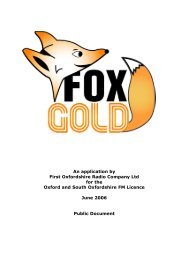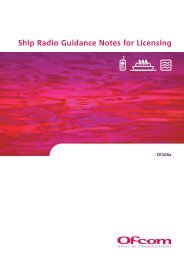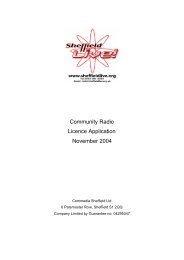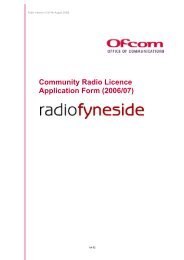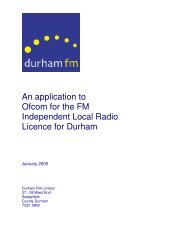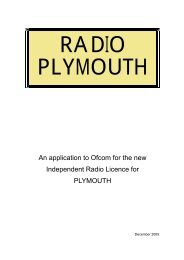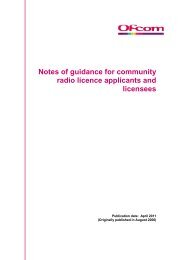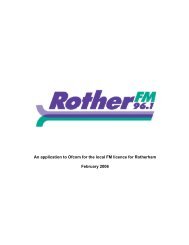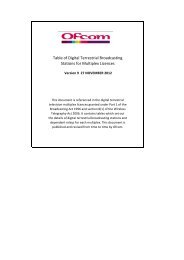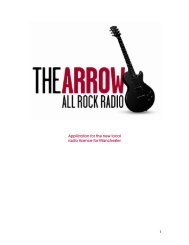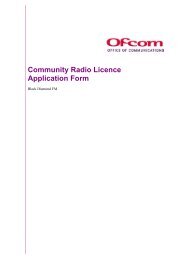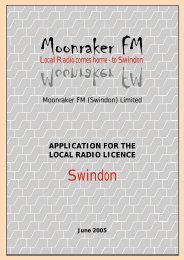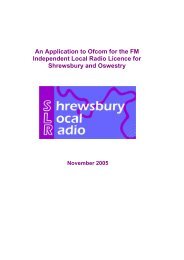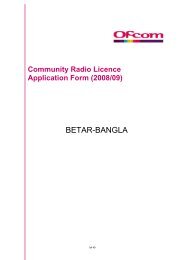Guidance Notes for a Point to Point Fixed Link ... - Ofcom Licensing
Guidance Notes for a Point to Point Fixed Link ... - Ofcom Licensing
Guidance Notes for a Point to Point Fixed Link ... - Ofcom Licensing
Create successful ePaper yourself
Turn your PDF publications into a flip-book with our unique Google optimized e-Paper software.
OfW 85 <strong>Guidance</strong><br />
<strong>Notes</strong> <strong>for</strong> an<br />
application <strong>for</strong><br />
a <strong>Point</strong> <strong>to</strong> <strong>Point</strong><br />
<strong>Fixed</strong> <strong>Link</strong> Licence<br />
– May 2008
How <strong>to</strong> fill In your licence application<br />
This guide has step by step instructions <strong>to</strong> help you fill in your<br />
OfW 85 application <strong>for</strong>m. It is particularly aimed <strong>for</strong> applicants<br />
who are less familiar with this licence process and <strong>for</strong> the<br />
initial application using the OfW 85 paper application <strong>for</strong>m.<br />
Please note that the application <strong>for</strong>m is only available in a<br />
‘rtf’ <strong>for</strong>mat on the web. It may be printed out, completed, and<br />
then sent <strong>to</strong> the address shown at the end of these notes, or<br />
completed electronically and e-mailed <strong>to</strong> us.<br />
Contact the <strong>Ofcom</strong> <strong>Licensing</strong> Centre during office hours on<br />
020 7981 3131 <strong>for</strong> help in completing the application, any<br />
other <strong>Ofcom</strong> <strong>for</strong>ms, or in<strong>for</strong>mation sheets referred <strong>to</strong> within<br />
these guidance notes. All in<strong>for</strong>mation sheets are also available<br />
on the <strong>Ofcom</strong> website www.ofcom.org.uk From time <strong>to</strong><br />
time the OfW 85 and the in<strong>for</strong>mation within these guidance<br />
notes may change, <strong>for</strong> example due <strong>to</strong> policy changes, etc.<br />
There<strong>for</strong>e please check that you have the latest release.<br />
1. Introduction<br />
The OfW 85 <strong>for</strong>m can be used <strong>for</strong> any <strong>Point</strong> <strong>to</strong> <strong>Point</strong><br />
<strong>Fixed</strong> <strong>Link</strong> (also known as ‘<strong>Fixed</strong> Terrestrial (<strong>Point</strong>-<br />
To-<strong>Point</strong>) <strong>Link</strong>’, ‘<strong>Fixed</strong> <strong>Link</strong>’, or ‘<strong>Fixed</strong> Terrestrial <strong>Link</strong>’)<br />
application that is <strong>to</strong> be deployed in geographical areas<br />
administered by <strong>Ofcom</strong>.<br />
1.1. Your responsibility<br />
You should design your system in accordance with the<br />
appropriate Technical Frequency Assignment Criteria<br />
(TFAC) available from the licensing section of our website.<br />
Also you should ensure that the system(s) comply<br />
with the licensing conditions stated in UK Interface<br />
Requirement 2000 (UK IR2000).<br />
Please fill in OfW 85 legibly, completely and accurately.<br />
Any missing in<strong>for</strong>mation may require us <strong>to</strong> return the<br />
<strong>for</strong>m <strong>to</strong> you.<br />
You can use OfW 85 <strong>to</strong> submit a single link application,<br />
or make multiple link applications with our electronic<br />
batch process. Please follow carefully the advice<br />
provided both in the OfW 85 <strong>for</strong>m and in these guidance<br />
notes. If you are unfamiliar with the batch process and<br />
conditions then please contact us <strong>for</strong> further advice.<br />
If you are making an application <strong>for</strong> the first time then<br />
you will be expected <strong>to</strong> pay the initial licence fee be<strong>for</strong>e<br />
we will process any subsequent applications or issue the<br />
licence documentation.<br />
Page 2 0f 8<br />
Remember, no matter who applies on your behalf you<br />
are still legally responsible <strong>for</strong> all actions carried out on<br />
your radio system.<br />
1.2. Our responsibility<br />
We aim <strong>to</strong> meet our published Quality of Service targets<br />
stated in OfW 85 which will apply when we receive a<br />
correctly completed application. In cases of uncertainty<br />
or missing in<strong>for</strong>mation we may attempt <strong>to</strong> contact you<br />
<strong>to</strong> resolve any points of detail or simply return the <strong>for</strong>m.<br />
When we are satisfied that all the correct details have<br />
been provided we will acknowledge this <strong>to</strong> the address<br />
stated in question B2.<br />
1.3. Licence requirements<br />
The licence is issued under the terms of the Wireless<br />
Telegraphy Act 2006. It is an instrument under which<br />
<strong>Ofcom</strong> authorises the use of radio apparatus <strong>to</strong> ‘a<br />
person’.<br />
1.4. <strong>Point</strong> <strong>to</strong> <strong>Point</strong> <strong>Fixed</strong> <strong>Link</strong> Spectrum<br />
Users can only obtain access <strong>to</strong> the spectrum through a<br />
licence, unless the spectrum is exempt from needing a<br />
licence.<br />
1.5. Conditions regarding use of the licence<br />
Your licence will be issued subject <strong>to</strong> the following<br />
requirements. Please read them carefully:<br />
• The licence supersedes all licences and schedules<br />
previously issued <strong>for</strong> the radio service.<br />
• The operation of a radio service other than in<br />
accordance with the terms and conditions of the<br />
licence is an offence.<br />
• The licence is valid until the renewal date on the<br />
licence, and thereafter so long as the licensee<br />
continues <strong>to</strong> pay the renewal fee <strong>to</strong> <strong>Ofcom</strong> on or<br />
be<strong>for</strong>e the renewal date.<br />
• All changes <strong>to</strong> the radio service must first be made<br />
known <strong>to</strong> and, if agreed, authorised by <strong>Ofcom</strong>.<br />
• The licensee must ensure that any new person<br />
operating the stations observes the conditions of the<br />
licence.<br />
• <strong>Ofcom</strong> may at any time revoke the licence or vary<br />
the licence conditions, within the existing Terms and<br />
Conditions, providing an explanation of the reason(s)<br />
<strong>for</strong> this action. In such circumstances, the licensee will<br />
be in<strong>for</strong>med using one of the following methods:
a) notice in writing sent <strong>to</strong> the licensee;<br />
b) a general notice given by public broadcast;<br />
• <strong>Ofcom</strong> reserves the right <strong>to</strong> change at any time the<br />
frequencies assigned <strong>for</strong> the licensee’s use.<br />
• The station(s) and the licence shall be available <strong>for</strong><br />
inspection at all reasonable times (or when an urgent<br />
situation occurs at any time) by a person acting under<br />
the authority of <strong>Ofcom</strong>.<br />
• The stations may be closed down at any time on the<br />
request of a person acting under the authority of<br />
<strong>Ofcom</strong>.<br />
• <strong>Ofcom</strong> reserves the right <strong>to</strong> assign frequencies<br />
specified in the licence schedule <strong>to</strong> additional<br />
licensees.<br />
The stations shall transmit and receive only on the<br />
frequencies specified in the licence schedule.<br />
1.6. <strong>Ofcom</strong> treatment of variation of contact details<br />
<strong>Ofcom</strong> will accommodate all contact changes <strong>to</strong> an<br />
existing licence, liaising with cus<strong>to</strong>mers as and when<br />
required. These changes are referred <strong>to</strong> as ‘licence<br />
amendment’ and will affect Section B of the OfW 85 only.<br />
Licence amendments concern changes <strong>to</strong> contact details<br />
changes, <strong>for</strong> example, permitting the licensee <strong>to</strong>:<br />
• make simple changes because of individual’s<br />
circumstances such as address, telephone number(s) etc;<br />
• indicate company account and technical personnel<br />
changes;<br />
• changes <strong>to</strong> company details etc.<br />
1.7. <strong>Ofcom</strong> treatment of variation of link technical<br />
details<br />
If technically feasible <strong>Ofcom</strong> will accommodate all<br />
technical link variations <strong>to</strong> an existing licence, liaising<br />
with cus<strong>to</strong>mers as and when required. These changes<br />
are referred <strong>to</strong> as ‘technical variations’ and will affect<br />
Section B (<strong>for</strong> identifying your licence number) and<br />
Sections C <strong>to</strong> F as appropriate <strong>for</strong> technical changes.<br />
Technical variations concern changes, <strong>for</strong> example,<br />
Section A Purpose of application<br />
A.1 Please put an X in the appropriate box<br />
You have six options <strong>to</strong> select from:<br />
1. Apply <strong>for</strong> a new link licence;<br />
2. Surrender an existing link licence;<br />
3. Vary contact details;<br />
4. Technically vary an existing link;<br />
5. Technical variation enquiry;<br />
6. Surrender an existing link licence (see the important<br />
note below).<br />
Page 3 0f 8<br />
permitting freedom <strong>to</strong>:<br />
• Deploy new radio equipment operating in a different<br />
bandwidth and using a different modulation scheme<br />
<strong>to</strong> that previously deployed on the existing link;<br />
• Deploy new antennas associated with different gains<br />
and per<strong>for</strong>mance <strong>to</strong> that deployed on the existing link;<br />
• Adjust antenna positioning;<br />
• Change frequency band;<br />
• Adjust polarisation etc.<br />
2. General advice be<strong>for</strong>e answering questions<br />
2.1. Be<strong>for</strong>e starting<br />
When completing an OfW 85 you may find it useful <strong>to</strong><br />
have access <strong>to</strong> the following in<strong>for</strong>mation:<br />
• UK Radio Interface Requirements 2000 (UK IR2000):<br />
<strong>Point</strong>-<strong>to</strong>-point radio relay systems operating in fixed<br />
service frequency bands administered by <strong>Ofcom</strong>.<br />
• Appropriate Technical frequency Assignment Criteria.<br />
• Spectrum Trading Guides.<br />
All are available from the licensing section of our<br />
website at: www.ofcom.org.uk<br />
Use these guidance notes <strong>to</strong> help you <strong>to</strong> answer the<br />
relevant questions.<br />
If you have any doubts about answering the question<br />
in the OfW 85 <strong>for</strong>m then please contact <strong>Ofcom</strong> be<strong>for</strong>e<br />
submitting your application.<br />
2.2. How <strong>to</strong> fill in the <strong>for</strong>m<br />
You are required <strong>to</strong> complete the OfW 85 by entering<br />
all relevant in<strong>for</strong>mation in the appropriate fields. Please<br />
write legibly and in black ink. When options are provided<br />
then please place an X against the relevant choice.<br />
2.3. How <strong>to</strong> answer the questions<br />
We suggest you start by answering Section A sequentially<br />
through the sections <strong>to</strong> Section G answering all relevant<br />
questions.<br />
Administrative variations do not require technical<br />
consideration or re-assignment and these are there<strong>for</strong>e<br />
more straight<strong>for</strong>ward <strong>for</strong> <strong>Ofcom</strong> <strong>to</strong> deal with. Option<br />
3 should be chosen <strong>to</strong> indicate a change in cus<strong>to</strong>mer<br />
details. Further advice is given in Section 1.6 above.<br />
Technical changes <strong>to</strong> a link should be indicated using<br />
Option 5 and typically this requires a re-assignment<br />
<strong>to</strong> be completed. Further details are given in Section<br />
1.6 above. Under spectrum trading there is now a<br />
requirement <strong>to</strong> provide in<strong>for</strong>mation <strong>to</strong> those intending<br />
<strong>to</strong> trade. There<strong>for</strong>e Option 6 is provided <strong>for</strong> this purpose.
Important Note:<br />
In future, a request <strong>to</strong> surrender a link licence will mean<br />
that the link is removed from the <strong>Ofcom</strong> assignment<br />
and licensing databases at the time of notification. This<br />
releases the channel <strong>for</strong> re-allocation <strong>to</strong> other users. If<br />
the existing licensee wishes <strong>to</strong> explore the possibility<br />
of trading a licensed link it is there<strong>for</strong>e important that<br />
they take no surrender action prior <strong>to</strong> the next licence<br />
renewal date.<br />
A.2 <strong>Ofcom</strong> will process and charge <strong>for</strong> your<br />
application on the basis of annual use unless you<br />
specifically indicate below it is <strong>for</strong> short-term use<br />
whereby it will be charged <strong>for</strong> each month of<br />
operation.<br />
Please answer accordingly:<br />
1. Short term use <strong>for</strong> a duration of months<br />
2. First extension <strong>for</strong> an authorised short-term use months<br />
3. Converting a short-term link <strong>to</strong> annual operation<br />
Section B Contact details<br />
B.1 If you already hold a point <strong>to</strong> point licence please<br />
enter your Organisational Identification Number<br />
and go <strong>to</strong> section C<br />
You will find this printed on one of your existing link<br />
licences.<br />
However, if there have been any changes <strong>to</strong> the contact<br />
details previously provided, or you have not provided<br />
a contact <strong>for</strong> Windfarm matters please provide this<br />
in<strong>for</strong>mation in Section B.<br />
B.2 To whom is the licence <strong>to</strong> be issued?<br />
Legally ‘a person’ may be an individual operating<br />
a business from one of their own premises or two<br />
or more people acting <strong>to</strong>gether as a Partnership,<br />
Company or an Incorporated Association. The WT<br />
Act licence must state the full name of the specific<br />
person, company or organisation so that the licence is<br />
quite clear. A list of legal entities is provided and you<br />
should choose one from the list. If the status of your<br />
organisation is not listed then you should specify this<br />
against ‘Other legal entity’. You are also required <strong>to</strong><br />
enter all appropriate contact details here. It is a legal<br />
requirement that the original licence must be sent <strong>to</strong><br />
the licence contact. This is the only address we will use<br />
<strong>to</strong> send you your licence and accompanying schedules.<br />
B.2.1 Company registration number<br />
Having a registration number is very much dependent<br />
on your legal status. You should check whether your<br />
legal entity requires you <strong>to</strong> do so. If so, please enter<br />
this in the box provided.<br />
B.3 Should the licensee, at B.2 also be contacted <strong>for</strong><br />
account matters?<br />
Either cross Yes and go <strong>to</strong> question B.3.2 or No and go<br />
<strong>to</strong> question B.3.1 <strong>to</strong> provide these details.<br />
Page 4 0f 8<br />
If appropriate, cross the box <strong>for</strong> converting a short-term<br />
link <strong>to</strong> annual operation.<br />
Please note that you are only permitted one extension <strong>for</strong><br />
a short-term licence under Option 2. Option 3 will extend<br />
the duration of use <strong>to</strong> the next renewal date after which it<br />
will be treated on the basis of annual use.<br />
A licence application that is required <strong>for</strong> less than 1 year<br />
will be considered as a short-term licence as long as this<br />
is your first application <strong>for</strong> this link. If you are applying<br />
<strong>for</strong> your first extension of a short-term link, please cross<br />
Option 2.<br />
If this is your second extension or you require the link<br />
<strong>for</strong> more than a year, then please cross Option 3.<br />
A.3 If you already hold a licence do you wish <strong>to</strong><br />
harmonise the payment renewal date?<br />
If so please state the renewal date of one of your<br />
existing link licences. This options permits you <strong>to</strong><br />
harmonise the renewal payment with an existing license<br />
should you require.<br />
B.3.1 If no, please provide the account contact details<br />
Please enter the contact details <strong>for</strong> account queries<br />
in the text spaces provided <strong>for</strong> name, address, <strong>to</strong>wn,<br />
postcode, telephone, fax and e-mail etc.<br />
B.3.2 Are you a third party contrac<strong>to</strong>r installing on<br />
behalf of a licensee?<br />
If you are third party contrac<strong>to</strong>r or handling agent you<br />
should cross the ‘Yes’ box , otherwise cross ‘No’.<br />
B.4 Who should be contacted <strong>for</strong> technical matters?<br />
If a contact given in question B.2 or B.3 is the same <strong>for</strong><br />
technical details then you should select the appropriate<br />
option, and go <strong>to</strong> section C. If not, you should provide<br />
these details under question B.4.1.<br />
B.4.1 If neither, please provide the technical contact<br />
details<br />
Please enter the contact details <strong>for</strong> technical queries<br />
in the text spaces provided <strong>for</strong> name, address, <strong>to</strong>wn,<br />
postcode, telephone, fax and e-mail etc.<br />
B.5 Who should be contacted <strong>for</strong> windfarm matters?<br />
If a contact given in question B.2 or B.4 is the same<br />
<strong>for</strong> windfarm details then you should select the<br />
appropriate option, and go <strong>to</strong> section C. If not, you<br />
should provide these details under question B.5.1.<br />
B.5.1 If neither, please provide windfarm contact<br />
details<br />
Please enter the contact details <strong>for</strong> windfarm queries<br />
in the text spaces provided <strong>for</strong> name, address, <strong>to</strong>wn,<br />
postcode, telephone, fax and e-mail etc.
Section C Common technical characteristics<br />
C.1 For a new application, please enter your own<br />
unique Cus<strong>to</strong>mer <strong>Link</strong> Reference<br />
This question is manda<strong>to</strong>ry <strong>for</strong> a new application but<br />
should be ignored if you are submitting either an<br />
amendment or cancellation. In which case, you should<br />
proceed <strong>to</strong> question C.2.<br />
For a new application, please fill in your own reference<br />
that uniquely identifies your system. You can use any<br />
combination of alpha/numeric characters. Please note<br />
that we will consider any characters such as ‘*’ and ‘\’<br />
etc. as a valid part of the Cus<strong>to</strong>mer System Reference.<br />
C.2 If this is a technical variation of an existing<br />
licensed link, please quote your existing Licence<br />
Number <strong>for</strong> this link<br />
When technically varying a link you should enter your<br />
licence number <strong>for</strong> this link in the space provided.<br />
C.2.1 If surrendering an existing licensed link, please<br />
quote your Licence Number <strong>for</strong> this link and go<br />
<strong>to</strong> Section G<br />
When surrendering a licensed link it is assumed that<br />
you are an existing cus<strong>to</strong>mer. You should enter the<br />
licence number of this link in the space provided.<br />
C.3 What frequency band do you prefer?<br />
You should cross the appropriate frequency band from<br />
the options provided etc.<br />
Section D <strong>Link</strong> details<br />
D.1 Please state the required service availability level<br />
between 99.9% and 99.999%<br />
You should specify the required service availability level<br />
which will determine the receiver median signal level<br />
(receiver sensitivity level plus fade margin). The Effective<br />
Isotropically Radiated Power (EIRP) is determined in dBW<br />
using:<br />
EIRP = Rx median signal level + Rx station feeder losses<br />
– Rx antenna gain + median path loss<br />
Section E Site details<br />
E.1 Is this a one-way link?<br />
You are required <strong>to</strong> cross one of the options.<br />
E.2 Please provide the link locations<br />
This question permits you <strong>to</strong> enter the location details in<br />
various <strong>for</strong>mats, which are:<br />
• National Grid Reference;<br />
• Latitude/longitude.<br />
Further advice on each type is provided below.<br />
Page 5 0f 8<br />
C.4 If appropriate, please specify the tuning range<br />
of the equipment<br />
This is an optional question which allows you <strong>to</strong><br />
provide any equipment carrier tuning ranges you wish<br />
us <strong>to</strong> consider <strong>for</strong> your assignment. This frequency<br />
range may be the equipment frequency range and<br />
must be specified between lower and upper frequency<br />
limits.<br />
For duplex operation you need specify only the ‘go’<br />
band limits. We will assume that the ‘return’ band<br />
limits are spaced above the ‘go’ band limits by the<br />
appropriate duplex spacing.<br />
The appropriate <strong>Ofcom</strong> Technical Frequency<br />
Assignment Criteria (TFAC) will provide the <strong>for</strong>mulae<br />
<strong>for</strong> calculating all carrier (channel) frequencies.<br />
If you specify a carrier tuning range in MHz, <strong>Ofcom</strong><br />
will attempt <strong>to</strong> assign the frequency (channel) in this<br />
range. If your assignment is unsuccessful then we will<br />
au<strong>to</strong>matically assign you the nearest available channel.<br />
You can accept, amend or cancel this at a later stage in<br />
the licence process. The ‘go’ band channel assignment<br />
will be associated with an equivalent channel<br />
assignment in the ‘return’ band segment.<br />
C.5 Please state your preferred polarisation<br />
Please cross ‘Vertical’, ‘Horizontal’, ‘Co-Channel Dual<br />
Polar’ or ‘No’ preference as appropriate.<br />
Cross the appropriate box <strong>for</strong> 99.9%, 99.95%, 99.99%,<br />
99.995%, 99.999% or within the permissible range state<br />
the actual value required.<br />
D.2 Please state the estimated length of the radio path<br />
You should enter the length of the path in kilometres.<br />
We will validate this against the site national grid<br />
references entered in E.2.<br />
For providing National Grid, Irish Grid and Easting/<br />
Northing:<br />
The extended grid reference is an extension of the<br />
National Grid Reference and is preferred by some<br />
applicants. Effectively this extends the Easting and<br />
Northing <strong>for</strong> sites outside the usual National Grid range<br />
and this is offered <strong>to</strong> cus<strong>to</strong>mers, who are already familiar<br />
with this extended grid system. We will be pleased <strong>to</strong><br />
assist cus<strong>to</strong>mers should they wish <strong>to</strong> know more about<br />
the applicability of this reference system.
The National Grid Reference (NGR) <strong>for</strong>mat is in three<br />
parts:<br />
• Part A is a two letter, 100 km, site square identifier <strong>for</strong><br />
mainland UK, or one letter <strong>for</strong> Northern Ireland, which<br />
identifies the specific grid square in the National Grid<br />
reference system;<br />
• Part B is <strong>for</strong> Easting;<br />
• Part C is <strong>for</strong> Northing.<br />
The preferred location precision <strong>for</strong> all frequency<br />
bands is 1 metre (i.e. five figure Easting and five figure<br />
Northing). You should always enter the numerical<br />
Easting and Northing in<strong>for</strong>mation starting from left <strong>to</strong><br />
right entering 0s <strong>for</strong> any unused spaces.<br />
For providing Latitude/Longitude:<br />
Alternatively, you can specify the location in Latitude/<br />
Longitude <strong>for</strong>mat. You are required <strong>to</strong> enter the Latitude<br />
and Longitude in a separate series of boxes which use<br />
degrees (°), minutes (') and seconds (").<br />
Remember when entering the longitude <strong>to</strong> also select<br />
E (ast) or W (est).<br />
E.3 Please give the site name and address<br />
For onshore sites, please enter the scanner site name<br />
details in the spaces provided <strong>for</strong> name, address, <strong>to</strong>wn,<br />
county and postcode. You should attempt <strong>to</strong> provide as<br />
much detail as possible. Where sites have been used<br />
be<strong>for</strong>e please provide us with the existing site name.<br />
Section F System details<br />
F.1 Please provide the Equipment Reference Code<br />
from the <strong>Ofcom</strong> website which can be found<br />
under the licensing section at: www.ofcom.org.uk<br />
The Equipment Reference Codes on the website show<br />
previously licensed and notified equipment. It is in<br />
no way an endorsed list of preferred equipment or a<br />
complete list of all notified fixed link equipment. It<br />
has been requested by licensees as a helpful reference<br />
<strong>for</strong> simplifying applications and <strong>for</strong> this reason it is<br />
published on our website.<br />
This is typically a spreadsheet periodically downloaded<br />
from our assignment system. The provided headings in<br />
single quotes from left <strong>to</strong> right are:<br />
1. Frequency ‘Band’ (GHz);<br />
2. ‘Description’ which is usually the manufacturer;<br />
3. ‘Model Number’ of the equipment;<br />
4. Unique equipment reference ‘Code’;<br />
5. ‘Bit Rate’ usually shown with channel spacing (e.g.<br />
155/28 <strong>for</strong> a 155 Mbit/s in 28 MHz system etc;<br />
6. ‘Active’ status either ‘Y’ or ‘N’. ‘N’ signifies that the<br />
equipment is old or not in production and we usually<br />
will not assign this equipment; and<br />
7. ‘R&TTE Notified’ signifying that the equipment has<br />
been successfully notified under the current R&TTE<br />
Page 6 0f 8<br />
We understand that sometimes providing postcode<br />
in<strong>for</strong>mation is difficult, particularly <strong>for</strong> rural locations.<br />
If so, please attempt <strong>to</strong> provide us with at least the first<br />
half of the post code.<br />
E.4 Please confirm the height of the antenna in<br />
metres above ground level (or mean sea level if<br />
offshore)<br />
For onshore sites, please provide the antenna height<br />
measured above ground level (AGL). For offshore sites,<br />
please provide the antenna height above mean sea level.<br />
E.5 If these are two new sites then please confirm<br />
which site should transmit in the upper half of the<br />
frequency channel plan, cross one option only<br />
Transmit high/low checking has been incorporated in<strong>to</strong><br />
the <strong>Ofcom</strong> general online register. You will be required<br />
<strong>to</strong> enter frequency range, location and search radius. The<br />
register will return a list of licences and whether they<br />
transmit high or low at these locations.<br />
You will be expected <strong>to</strong> check any sites against the<br />
online register be<strong>for</strong>e submitting your application. For<br />
existing sites, from which licensed links are transmitting,<br />
<strong>Ofcom</strong> will maintain the established high/low transmit<br />
status <strong>for</strong> these sites. For new sites, where no high/low<br />
status is provided from the register, please state which<br />
site you would like <strong>to</strong> transmit high.<br />
Directive by ‘Y’ or approval was under the old<br />
national type approval regime using UK national MPT<br />
regulations by ‘N’.<br />
When making your application it is the code (item 4)<br />
which is required. The application <strong>for</strong>m prefixes this<br />
code with ‘E’ <strong>for</strong> equipment <strong>for</strong> clarity. You should<br />
ensure that when entering this code that you enter the<br />
in<strong>for</strong>mation accurately from left <strong>to</strong> right, taking notice of<br />
any code separa<strong>to</strong>rs ‘/s’ and any other special characters.<br />
If you are unable <strong>to</strong> find the relevant Equipment<br />
Reference Code on the website then you should contact<br />
us directly be<strong>for</strong>e sending your application <strong>to</strong> us.<br />
As examples, two valid entries <strong>for</strong> 38 GHz 155 MBit/s in<br />
28 MHz systems are:<br />
• 38/DT/0/43/DM <strong>for</strong> ALTIUM 38GHZ STM-1; and<br />
• 38/DT/2/91/NE <strong>for</strong> PASOLINK PLUS 38GHz.<br />
If the equipment code is not available from the website<br />
then either complete question F.1.1 or contact us directly<br />
be<strong>for</strong>e making your application.<br />
F.1.1 If the Equipment Reference Code is not known<br />
please specify the following:<br />
Equipment manufacturer, ETSI spectral efficiency class,<br />
equipment model number, bit rate, bandwidth and<br />
modulation level and type
If you cannot find the code <strong>for</strong> the equipment then<br />
you should specify this in<strong>for</strong>mation which will help<br />
us <strong>to</strong> process your application quicker and make any<br />
necessary enquiries <strong>to</strong> ensure that the equipment<br />
has been correctly notified, and if so, update the<br />
Equipment Reference Number spreadsheet <strong>for</strong> future<br />
applications. Occasionally manufacturers change their<br />
name from time <strong>to</strong> time and sometimes this confuses<br />
the identification of equipment. So we can uniquely<br />
identify the correct piece of equipment we also like you<br />
<strong>to</strong> specify the minimum equivalent PDH/SDH (bit rate),<br />
ETSI spectral efficiency class, bandwidth, and modulation<br />
with level. Then we can be certain we have the correct<br />
equipment details.<br />
F.2 Please provide the Antenna Reference Code from<br />
the <strong>Ofcom</strong> website which can be found under the<br />
licensing section at: www.ofcom.org.uk<br />
The Antenna Reference Codes on the website show<br />
previously licensed and notified antenna equipment.<br />
It is in no way an endorsed list of preferred equipment<br />
or a complete list of all notified fixed link antennas. It<br />
has been requested by licensees as a helpful reference<br />
<strong>for</strong> simplifying applications and <strong>for</strong> this reason it is<br />
published on our website.<br />
Typically a spreadsheet periodically downloaded from<br />
our assignment system. The provided headings in single<br />
quotes from left <strong>to</strong> right are:<br />
1. Frequency ‘Band’ (GHz);<br />
2. ‘Description’ which is usually the manufacturer;<br />
3. ‘Model’ number of the antenna;<br />
4. Unique equipment reference ‘Type’;<br />
5. ‘Antenna Description’ usually a free text field with<br />
additional in<strong>for</strong>mation e.g. full absorber, side ear<br />
absorber, no absorber etc.;<br />
6. ‘Per<strong>for</strong>mance’ status either ‘H’, ‘S’ or ‘O’ respectively<br />
<strong>for</strong> high per<strong>for</strong>mance, standard per<strong>for</strong>mance or other<br />
per<strong>for</strong>mance.; and<br />
7. ‘Size’ signifying antenna diameter in metres, <strong>for</strong><br />
example 0.3, 0.6 etc;<br />
8. ‘Gain’ signifying bore sight gain in dBi, <strong>for</strong> example<br />
38 and 43 etc; and<br />
9. ‘Beam Width’ specifying the half-power 3dB<br />
beamwidth in degrees, <strong>for</strong> example 1 or 2.<br />
When making your application it is the type (item 4)<br />
which is required. The application <strong>for</strong>m prefixes the<br />
type code with ‘A’ <strong>for</strong> antenna <strong>for</strong> clarity. You should<br />
ensure that when entering this code that you enter the<br />
in<strong>for</strong>mation accurately from left <strong>to</strong> right, taking notice of<br />
the code separa<strong>to</strong>rs ‘/s’ and any other special characters.<br />
If you are unable <strong>to</strong> find the relevant Antenna Reference<br />
Code on the website then you should contact us directly<br />
be<strong>for</strong>e sending your application <strong>to</strong> us.<br />
As examples, two valid entries <strong>for</strong> high per<strong>for</strong>mance<br />
38 GHz antennas are:<br />
Page 7 0f 8<br />
• A/38/H/97/10/AA <strong>for</strong> 0.3 metre parabolic; and<br />
• A/38/H/91/6/FM <strong>for</strong> 0.2 metre lens horn.<br />
If the antenna code is not available from the web site<br />
then either complete question F.2.1 or contact us directly<br />
be<strong>for</strong>e making your application.<br />
F.2.1 If the Antenna Reference Number is not known<br />
please specify the following:<br />
Antenna manufacturer, ETSI spectral efficiency class,<br />
antenna model number and the antenna maximum<br />
(boresight) gain<br />
If you cannot find the code <strong>for</strong> the antenna then you<br />
should specify this in<strong>for</strong>mation which will help us<br />
<strong>to</strong> process your application quicker and make any<br />
necessary enquiries <strong>to</strong> ensure that the equipment has<br />
been correctly notified, and if so, update the Antenna<br />
Reference Number list. Also, occasionally manufacturers<br />
change their name from time <strong>to</strong> time and sometimes<br />
confuse the identification of equipment.<br />
F.3 Please state the feeder losses<br />
You are required <strong>to</strong> provide the value of the feeder loss<br />
in dB. This value should be rounded <strong>to</strong> the nearest dB.<br />
The loss may be 0dB as in the case of an integrated<br />
transceiver with parabolic antenna operating above 25<br />
GHz or the equipment might be connected by a run of<br />
waveguide with typically 2dB feeder loss.<br />
At lower frequencies we normally expect a value greater<br />
much greater than 0dB <strong>for</strong> feeder losses connecting<br />
the terminal indoor and outdoor units. In exceptional<br />
conditions this might exceed 15dB <strong>to</strong> 20dB where the<br />
units are connected by waveguide or coaxial cable.<br />
F.4 Please state any other losses<br />
You are required <strong>to</strong> provide the value of any other<br />
system losses such as branching or hot standby losses<br />
in dB. This value should be rounded <strong>to</strong> the nearest dB.<br />
Acceptable losses on a band-by-band basis are stated<br />
in our published Technical Frequency Assignment<br />
Criteria. We use this criterion <strong>to</strong> judge whether your<br />
requirements are reasonable. <strong>Ofcom</strong> does not generally<br />
permit the use of frequency diversity <strong>for</strong> standby<br />
purposes. You should note that we don’t encourage the<br />
use of N+1 systems.<br />
F.5 Feeder losses greater than 10 dB and other losses<br />
greater than 4dB need <strong>to</strong> be justified. If the losses<br />
in question F.4 and/or F.5 exceed these limits,<br />
please provide justification below.<br />
This question provides boxes <strong>to</strong> justify any untypical<br />
feeder or other losses. We retain the right <strong>to</strong> challenge<br />
or refuse any losses which seem unreasonable. Generally,<br />
acceptable feeder losses are no more than 10dB and<br />
combined other losses no more than 4dB. We require<br />
justification <strong>for</strong> values greater than these limits and will<br />
consider these on a case-by-case basis. Descriptions of<br />
excessive losses are required <strong>for</strong> both sites.
F.6 Does the system including antennas meet<br />
the licensing requirements of UK Interface<br />
Requirement 2000 (UK IR2000)?<br />
Section G Declaration<br />
Following the granting of any licence the licensee has 28 days<br />
in which <strong>to</strong> raise any objections <strong>to</strong> the conditions contained<br />
therein. The applicant completing the application should<br />
provide his or her name in capital letters, enter the date of the<br />
application in the following <strong>for</strong>mat dd/mm/yyyy.<br />
It is helpful from an evidential point of view if the applicant<br />
signs the declaration <strong>to</strong> acknowledge their obligation <strong>to</strong> state<br />
the truth. Applicants who submit their <strong>for</strong>m electronically will<br />
be deemed <strong>to</strong> have acknowledged this declaration (in Section G)<br />
by the act of making this electronic submission<br />
If you have not received acknowledgement of your application<br />
within two working weeks you should contact <strong>Fixed</strong> <strong>Link</strong>s<br />
<strong>Licensing</strong> at the address below.<br />
Page 8 0f 8<br />
Please cross ‘Yes’ or ‘No’ as appropriate. It is the<br />
responsibility of the applicant <strong>to</strong> ensure that the<br />
proposed scanner equipment is licensable. See UK<br />
IR2000. Your equipment supplier will be able <strong>to</strong> advise<br />
you on eligibility.<br />
Useful contacts <strong>for</strong> further advice on completing OfW 85<br />
Completed applications should be sent <strong>to</strong>:<br />
<strong>Fixed</strong> <strong>Link</strong> <strong>Licensing</strong><br />
<strong>Ofcom</strong> <strong>Licensing</strong> Centre<br />
PO Box 56373<br />
London SE1 9SZ<br />
Telephone 020 7981 3131<br />
0300 123 1000<br />
Facsimile 020 7981 3235<br />
E-mail: fixedlinklicensing@ofcom.org.uk<br />
Ref: Ofw.103/Fol.136_05/08



